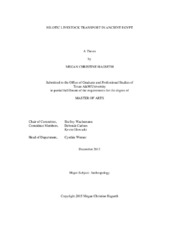| dc.description.abstract | Cattle in ancient Egypt were a measure of wealth and prestige, and as such figured prominently in tomb art, inscriptions, and even literature. Elite titles and roles such as “Overseer of Cattle” were granted to high ranking officials or nobility during the New Kingdom, and large numbers of cattle were collected as tribute throughout the Pharaonic period. The movement of these animals along the Nile, whether for secular or sacred reasons, required the development of specialized vessels. The cattle ferries of ancient Egypt provide a unique opportunity to understand facets of the Egyptian maritime community.
A comparison of cattle barges with other Egyptian ship types from these same periods leads to a better understand how these vessels fit into the larger maritime paradigm, and also serves to test the plausibility of aspects such as vessel size and design, composition of crew, and lading strategies. Examples of cargo vessels similar to the cattle barge have been found and excavated, such as ships from Thonis-Heracleion, Ayn Sukhna, Alexandria, and Mersa/Wadi Gawasis. This type of cross analysis allows for the tentative reconstruction of a vessel type which has not been identified previously in the archaeological record.
Elements of hull construction have been identified primarily in tomb art and tribute lists, but are supported by the remains from other types of working vessels recovered from archaeological excavations. Unique to some examples of this type of vessel are the deck structures used to contain cattle during transport. Proposals for the configuration and specifications of these deck pens also are developed in this thesis.
Cattle boats of the Pharaonic period frequently appear in the reliefs of elite tombs during the Middle and New Kingdom. This vessel’s associations with elite status and wealth, despite the fact that it was a working vessel, provide a unique window through which we can gain new insight on the powerful and long-lived Egyptian civilization. | en |


